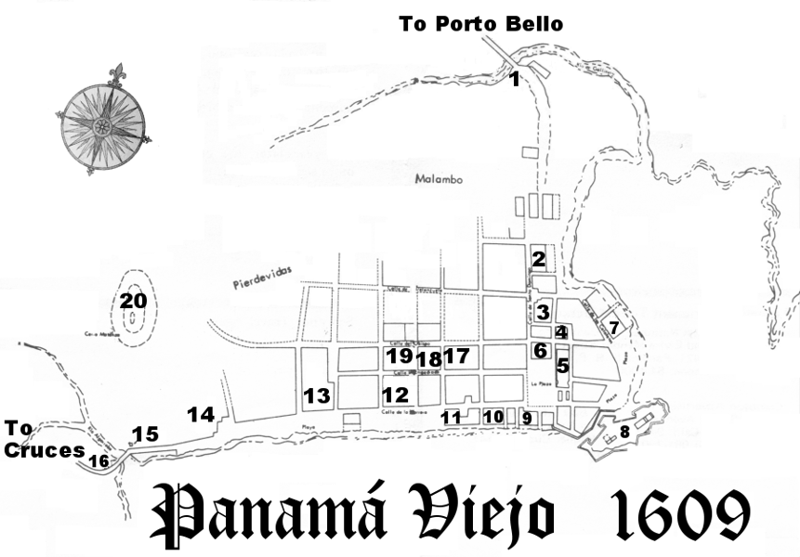
Panamá Viejo - City Map
|
|
This map is base on the city chart made by Spanish Engineer, Roda
|
King's Bridge - Construction started in 1617 took several years to replace the old wooden one, at a cost of 20,000 Pesos. The new bridge was constructed of stone and is located on the road to Portobelo over the Kings Highway. |
|
|
2 |
Convento de San Jose - The walls of San Jose Church and Convent are still visible and about 110 feet by 59 feet. It has smaller chapels on both sides of the main altar, which was the home of the "Golden Alter". This church belonged to the Agustine Monks. This altar was white washed and more colors painted on, just before Henry Morgan attacked the city. This plan to deceive the pirates worked and the altar was spared. This convent did not burn in the fire of 1671, due to its distance from the main part of town. The altar was moved to the new city of Panamá, into the new San Jose Church. |
|
Convento de Santo Domingo - Located North of the Plaza Mayor, it included a convent and a church built on one acre of land. This was run by the Dominican Friars, and was one of the smallest churchs in town. The convent was established in 1571, and the stone structure was constructed after 1590. These structures, were lost during the fire. |
|
|
El Obispado - The home and offices of the Catholic Bishop for the colony. |
|
|
La Catedral - This was the most important church in the city, in the main plaza. Originally constructed of wood in 1535 and reinforced in 1580. The stone structure was started in 1610 and took 16 years to complete. |
|
|
6 |
Cabildo Municipal - The Municipal Building was originally built behind the Cathedral. The building was destroyed in 1612 by an earthquake. When it was rebuilt, it was built of masonry, much large and relocated to the Plaza Mayor. |
|
7 |
Casa de Genovese - Slave Market was built to house thousands of African slave, imported into Panamá to replace in Indians. The native Indians were insufficient in numbers to meet the large demand for labor. Especially for the transportation of the Treasures to the Caribbean and merchandise back across the Isthmus. |
|
8 |
Casas Reales - Built in 1556, this complex included the Quartermaster Building, the Court, the Chancellory, the Gun Powder Deposit, the Royal Audience Court and the Residence of the Governor. |
|
9 |
Jail - The local jail, used to house prisoners. This building was on the seawall, and was heavily damaged by the sea. |
|
10 |
Kitchens - The main kitchens, used to cook the food for the slaves and garrison. This building was on the seawall, and was heavily damaged by the sea. |
|
11 |
Matadero - This was the local slaughter house This building was on the seawall, and was heavily damaged by the sea. |
|
12 |
San Juan de Dios Hospital - Originally called San Sebastian's Hospital, this was built by the government and run by nuns until 1620, when the friars of San Juan, took over. The hospital includes grounds and a church. |
|
13 |
Convento de San Francisco - This convent was run by the Franciscan friars. The Franciscan's were among the first settlers in Panamá, sometime during the 1520's. They established their convent in 1573. In 1603, they constructed the church and monestary of stone. Most of the friars were killed rendering aid to the wounded, during the pirates attack. |
|
14 |
Convento de la Merced - This is one of the most beautiful, of the ruins of the city. Francisco Pizarro and his men celebrated mass and had communion, before they started their third (final) expedition to Peru. This convent was used as Henry Morgan's headquarters, in 1671, after they saved it from the flames. The church was also used as a warehouse to store the Pirates booty. |
|
15 |
Castillo de La Navidad - This fort protected the western entrance to the city. It was constructed in 1658, and had a garrison of 50 men, 6 cannons and a small gun power deposit. The fort proved inefective against the Pirates. |
|
16 |
Matadero Bridge - This bridge was also called the "Morgan Bridge" because this was the bridge that Morgan used to gain enterance to the city, in 1671. It was later called the Matadero Bridge, because it was used by the farmers, when they took their livestock to get slaughtered. This bridge is on the road to Cruces and el Castillo de San Lorenzo. |
|
Convento de la Compańia de Jesus and Church - Built in 1607, this stone structure was destroyed by fire in 1671, during Henry Morgan's attack. It was built by the Jesuits, who were late comers to the city. It probably served has a school, since the Jesuits established the first primary and secondary schools in Panamá |
|
|
18 |
Iglesia de la Concepcion - The Sisters of Our Lady of the Immaculate Conception founded this convent in 1598, and it served as a girls school. First constructed of wood, it was later rebuilt of stone in 1690 |
|
Convento de la Concepcion - This was the convent that was next door the the church. |
|
|
20 |
Monasterio de San Cristobal - Destroyed |
|
|